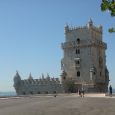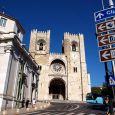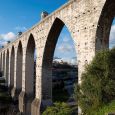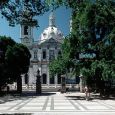Lisbon
Advertisement
By Air
Portela International Airport (LIS) is a single terminal facility situated right inside the urban infrastructure of Lisbon, seven kilometres north of the city centre. The airport handles flights between major international destinations across the world including London, New York, Sydney, Los Angeles and Toronto as well as several daily scheduled flights between major European cities.
The airport has been undergoing renovations and upgrades, and most major facilities and amenities are offered here including ATMs, postal services, banks and money changing as well as several lounges.
Transport to the city centre is available on the Aerobus line 91, with services departing every 20 minutes, while city bus lines 5, 8, 22, 44, 45 and 83 offer alternative services. Taxis are also readily available, although travellers should note that an extra charge applies for each item of luggage. The airport also sells vouchers for taxis, which are good for anywhere in Lisbon and are inclusive of the luggage charge. Vouchers may cost slightly more than if you bargain hard for your fare, but they can be a wise purchase in light of a rise in dishonest taxi drivers.
By Rail
Train travel within Portugal and Lisbon is pleasant and reliable. Two major train stations serve central Lisbon: Santa Apolónia and Orient Station, and three others handle services to the outer areas. The national rail service provider is Caminhos de Ferro Portugueses. All Portuguese train lines connect with services to Lisbon and Porto. Overnight trains are available to connect travellers with Paris, a 19-hour journey, and Madrid, a 10-hour journey.
By Bus
The main bus station is located near Saldanha metro terminal, on Avenida Casal Ribeiro, and this is primarily where international bus services arrive and depart from. Inter-Centro runs buses from points in the UK, France and Spain. Rede Nacional de Expressos offers coach services to several destinations within Portugal.
Belem Tower
The Torré de Belém is certainly Lisbon's most famous construction and at the same time most well known symbol. It stands surrounded by lawns on the bank of the Tagus to the west of the Hieronymite monastery. At this point the Tagus widens into a large bay.
Originally conceived as a lighthouse and simultaneously a defensive fortress for the port of Restelo, Manuel I had the tower built in 1515 on a small island off the river bank. Many old views of the city show the Torré de Belém at a distance from the mainland surrounded by the waters of the Tagus. A former, older tower on the opposite bank and Belém's fortress tower were supposed to afford maximum protection for the harbor. A general shift in the location of the river bank has resulted in the tower now standing on the mainland right on the water's edge: a footbridge leads across an artificial basin to the entrance to the tower.
Francisco de Arruda began the construction in 1515. De Arruda came from Alentejo and was one of the most famous architects to use the Manueline style. He had studied with his older brother Diogo de Arruda, had then worked for some time in north Africa and was thus acquainted with the elements of the Arabic style - one of the reasons for the obvious Moorish influences in his work.
The Torré de Belém has been the setting for many historical events. These included the onset of Spain's 60 year rule of Portugal after the conquest of the tower in 1580. After Lisbon was taken by Napoleonic troops in 1807 the two upper stories of the tower were destroyed and wooden houses built in their place. In 1845 Minister Terceira had the tower restored to its original state.
Nations Park
Originally built for Expo ‘98, this site has been converted into an all-encompassing park, featuring shopping outlets, a host of leisure activities, concert halls, bars and restaurants as well as a splendid walkway along the River Tagus. The landmark edifice of the park is also Lisbon’s tallest building: the prominent Torre Vasco da Gama features an observation deck and a restaurant.
Visitors to Nations Park can also visit one of Europe’s largest aquariums, the Oceanário. The aquarium features huge pools of sharks, manta rays, otters and penguins. The Oceanário is also linked with the Torre Vasco da Gama by a cable car, which offers breathtaking views of the site. The park is very popular with Portuguese families during the summer months, and a three-day park card is available, covering admission to several attractions as well as providing discounts on food, shopping and parking.
S Cathedral
In the 12th century, Portugal’s first king, Dom Alfonso Henriques, built this cathedral, mainly in a Romanesque style, while other architectural design elements were added after the major earthquake in 1755. The cloister dates back to the 13th century, and the Baroque sacristy holds the remains of Lisbon’s patron saint, St Anthony. A small museum is also housed within the cathedral.
guas Livres Aqueduct
The massive arches that comprise the Aqueduto das Águas Livres survived the 1755 earthquake, and the structure is now listed as a national monument. The stone structure was built in the Baroque style in 1748 by architects Manuel da Maia and Custodio José Vieira, and is a major architectural attraction despite being situated 18kms from the city centre.
Star Basilica
To the northwest of the city center, on one of Lisbon's many hills, stands the Basilica da Estrela. Its striking position and gleaming white dome make it resemble the National pantheon, which is situated considerably further to the east but whose dome causes them to be easily confused, and which is a prominent point of reference in a panoramic overview of Lisbon.
The church is regarded as the most important sacred building in the Portuguese capital dating from the second half of the 18th century Queen Maria I ordered the construction of the church. She had taken a vow to have a church built if she bore a son and thus a successor. Her son José was born but died, however, two years before the church was completed.
September - October






